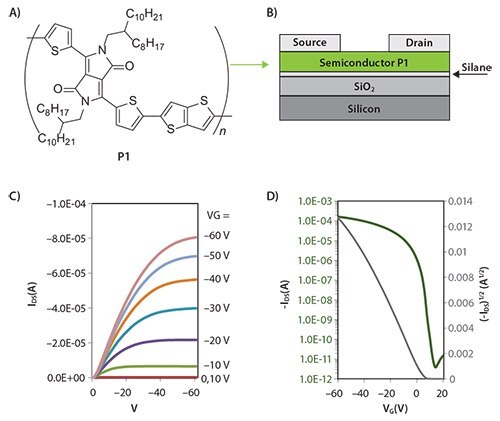High-Performance Semiconductor Polymers Based on Diketopyrrolopyrrole and Thienothiophene
Tony Wigglesworth, Yiliang Wu, Cuong Vong, Matthew Heuft
Xerox Research Centre of Canada, Mississauga ON, L5K 2L1
Introduction
The development of high-performance conjugated organic molecules and polymers has received widespread attention in industrial and academic research. This widespread interest is motivated by the numerous applications for these materials in optoelectronic devices such as organic light emitting diodes (OLEDs),1 organic field-effect transistors (OFETs),2 sensors,3 and organic photovoltaic (OPV) devices.2 Compared to their inorganic counterparts, organic materials offer unique advantages, such as lightweight, solubility, and compatibility with flexible substrates so they can be fabricated into electronic devices using low-cost printing techniques.
Diketopyrrolopyrrole (DPP)-based materials have emerged as one of the most promising material platforms for developing high-performance polymers for printed electronics applications.4 DPP polymers have excellent aggregating properties due to the strong donor–acceptor interactions induced by the electron-deficient DPP chromophore. This has led to record-breaking p-type mobilities of 5–10 cm2V-1s-1 for polymerbased, solution-processed OFETs.5,6 This versatile class of semiconductor polymers has also been utilized in bulk hetero-junction solar cells with [C60]PCBM (Prod. Nos. 684457, 684449, and 684430) and [C70] PCBM (Prod. No. 684465) acceptors and photoconversion efficiencies (PCE) ranging from 3−7% have been demonstrated.7
Among the numerous DPP-based materials that have been investigated, diketopyrrolopyrrole-thienothiophene (DPP-TT) copolymers have emerged as one of the most promising p-type organic semiconductor polymers developed in recent years. This article highlights the applications of DPP-TT copolymers in solution-processed OFET devices.
Solution-processed Organic Field-effect Transistors
DPP-TT copolymers are soluble in common organic solvents such as chloroform, chlorobenzene, dichlorobenzene, and xylene for fabrication of OFET devices using solution processing. DPP-TT copolymer P1 (Prod. No. 791989) has been extensively studied due to the excellent performance in both OFET and OPV devices. For example, this DPP-based polymer has been discussed in several publications with the reported mobility ranging from 1–10 cm2V-1s-1 depending on the polymer molecular weight and the device architecture.6,8 Li et al. demonstrated a benchmark performance of 10 cm2V-1s-1 in a solution-processed organic thin film transistor (OTFT) with polymer P1.6 This outstanding performance is driven by the high molecular weight (Mw=501 kDa) polymer attained in this example. However, despite this remarkable device performance, DPP-based polymers are predominantly processed from halogenated organic solvents which prohibit their use in large-scale commercial applications. In this report, we demonstrate that DPP-TT transistors with performance approaching 1 cm2V-1s-1 can be fabricated from non-halogenated aromatic solvents under ambient conditions. We found that polymer P1 with a weight average molecular weight of Mw=35–50 kDa has excellent solubility in xylene solvents and investigated the device performance in solution processed OFETs.
Device Fabrication
Top-gate bottom-contact OFETs were prepared on n-doped silicon wafers with a 200 nm native oxide layer. The SiO2 dielectric layer was modified with an octyltrichlorosilane (OTS) (Prod. No. 235725) or an octadecyltrichlorosilane (ODTS) (Prod. No. 104817) selfassembled monolayer (SAM) by immersing plasma cleaned substrates in a 0.1 M toluene solution at 60 °C for 20 and 40 minutes, respectively. After silane modification, the wafers were thoroughly cleaned with toluene and isopropanol. The semiconductor layer was prepared by saturating the substrate with a 0.7 wt% p-Xylene solution of polymer P1. The solution was allowed to stand on the substrate for 2 minutes and spun at 1,000 rpm for 60 seconds, forming a uniform 25−50 nm thick film of polymer P1. The film was vacuum-dried at 80 °C for 10 minutes and annealed at 140 °C in vacuum. 90 μM channel devices were fabricated by vacuum-evaporating 60 nm gold electrodes through a shadow mask and the device performance was characterized using a Keithley SCS-4200 system. The polymer chemical structure, device architecture, and typical source-drain curves are shown in Figure 1.

Figure 1.A) Chemical structure of DPP-TT. B) Top-Contact Bottom-Gate (TCBG) device architecture. C) Output curves of a typical DPP-TT transistor. D) Typical transfer curves of TCBG (L = 90 μM and W = 1,000 μM) OTFT devices.
For 90 μM channel devices the average saturated p-type mobility of a spin-coated device on octyltrichlorosilane (OTS) modified SiO2 dielectric was 0.60 }0.07 cm2V-1s-1. Devices fabricated on ODTS-modified silicon substrates further improved the average saturated mobility to 0.96 }0.08 cm2V-1s-1, with some devices reaching a maximum mobility of 1.02 cm2V-1s-1.
Conclusion
Diketopyrrolopyrrole-thienothiophene (DPP-TT) copolymers are one of the most promising semiconductor materials for applications in printed electronics due to their outstanding aggregation properties provided by strong donor–acceptor interactions and solution processability. These DPP-TT copolymers have led to benchmark performance in solution-processed OFETs and OPV devices.6,7c Also, nonhalogenated solvent processing has been recently demonstrated with device performance approaching the high end of amorphous silicon transistors (0.5–1.0 cm2V-1s-1). In addition, high-performance devices can be obtained with DPP-TT copolymers at annealing temperatures of 140 °C, which is compatible with low-cost plastic substrates.
Materials
References
To continue reading please sign in or create an account.
Don't Have An Account?